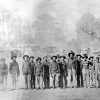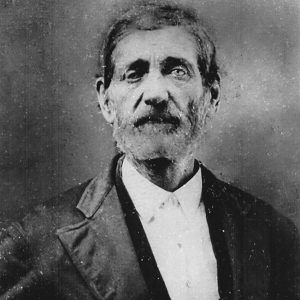calsfoundation@cals.org
James Spencer Rains (1817–1880)
Serving in the Missouri State Guard, James S. Rains led troops at the Battle of Pea Ridge in Arkansas and several engagements in Missouri. Never officially commissioned into the Confederate army, and despite a dismal performance, he nevertheless held multiple commands during the first year and a half of the Civil War.
Born on October 2, 1817, in Tennessee, Rains was the son of Asahel Rains and Malvina Duncan Rains. His older brother, Emory Rains, moved to Texas the year Rains was born, serving in both the Texas Congress and the state legislature. His maternal uncle was Alexander Duncan, a member of the U.S. House of Representatives from Ohio in the 1830s and 1840s. Little is known of the early life of Rains, and he moved to Missouri by 1840. Residing in the southwestern corner of the state, Rains farmed and entered public service.
Elected county court justice in 1841, he won a seat in the Missouri House of Representatives in 1844 and received an appointment as the Indian Agent for the Neosho Subagency of the Seneca Reserve in the Indian Territory. Another appointment followed with service in Kansas before he lost the position in 1849 based on charges of misconduct that occurred in Neosho. Rains traveled to California the following year, where he helped organize the state militia and received an unspecified rank of general. Returning to Missouri in 1855, he won a seat in the state Senate the same year. Leaving the Democratic Party, he became a Know-Nothing before running unsuccessfully for a congressional seat as a Constitutional Unionist in 1860. He married Margaret Jane Cravens, and the couple had three children.
Upon the secession of the southern states, Rains supported the secession of Missouri. He received the rank of brigadier general in the Missouri State Guard on May 18, 1861, and took command of the Eighth Division. Although he proved to be a good recruiter, he was less prepared to be a military leader and reportedly suffered from an inability to discipline his men.
Rains led his men at the Battles of Carthage and Dug Springs, where his men were routed while he commanded the entire force of Missouri State Guard. He later fought at the Battles of Wilson’s Creek and Dry Wood Creek. Moving with other Missouri State Guard Units, Rains led his division at the Battle of Pea Ridge in March 1862. Following the battle, Rains vocally criticized the performance of the Confederate commander, Major General Earl Van Dorn, and was arrested for the criticism. The charges were eventually dropped as Van Dorn led most of the army across the Mississippi.
Remaining in Arkansas, Rains gained the support of the new commander of the Department of the Trans-Mississippi, Major General Thomas C. Hindman. Short of officers, men, and supplies, Rains commanded troops in the Fayetteville (Washington County) area in the summer of 1862. Surprised by a Federal force on July 15, Rains and his men were defeated in a small battle in that city. The situation was unique, as Rains was not a member of the Confederate army but rather the Missouri State Guard.
By August, Rains commanded a small force at Fort Smith (Sebastian County) and was joined by Hindman to prepare movements into northwestern Arkansas and southwestern Missouri. In September, Hindman received orders to report to Little Rock (Pulaski County) and left Rains in charge with orders to hold the line in Missouri, telling him not to make any aggressive movements. Maneuvering in the area continued over the next month, and troops under Rains’s overall command fought at the First Battle of Newtonia on September 30. Subordinates of Rains later criticized his commands before the battle and his transfer of units to different areas where they were not available to participate in the fight. Although the Confederates won the battle, Union forces converged on the town and forced Rains to abandon the position, leading to Federal troops entering northwestern Arkansas.
Hindman removed Rains from command on October 22, 1862, allowing him to resign his command after a charge of drunkenness was laid. Both Hindman and his replacement as commander of the department, Lieutenant General Theophilus Hunter Holmes, expressed dissatisfaction with Rains’s performance in the field. Upon leaving active service, Rains moved to Texas. He returned to the field in 1864, participating in Sterling Price’s Missouri Raid. Leading Missouri State Guard troops in the expedition, he returned to Arkansas after the effort was repulsed. A letter written on December 12, 1864, reported that Rains commanded about 200 men in Richmond (Little River County) and that the guardsmen were “committing many depredations” on the civilians of the area. The men under his command were eventually transferred to regular Missouri units. In the last days of the war, Rains was back in Missouri working to raise additional troops.
After the war, Rains resided in Texas, where he ran for lieutenant governor in 1878 on the Greenback ticket. He worked as a farmer, lawyer, and railroad promoter. He died on May 19, 1880, and is buried in Seagoville, Texas. His wife Margaret died while visiting family in Fort Smith in 1885 and is buried in that city.
For additional information:
Allardice, Bruce S. More Generals in Gray. Baton Rouge: Louisiana State University Press, 1995.
Bearss, Edwin C. “The Federals Raid Van Buren and Threaten Fort Smith.” Arkansas Historical Quarterly 26 (Summer 1967): 123–142.
Piston, William Garrett, and Richard W. Hatcher III. Wilson’s Creek: The Second Battle of the Civil War and the Men Who Fought It. Chapel Hill: University of North Carolina Press, 2000.
Shea, William L. Fields of Blood: The Prairie Grove Campaign. Chapel Hill: University of North Carolina Press, 2009.
Shea, William L., and Earl J. Hess. Pea Ridge: Civil War Campaign in the West. Chapel Hill: University of North Carolina Press, 1992.
David Sesser
Southeastern Louisiana University


 James S. Rains
James S. Rains 



Comments
No comments on this entry yet.